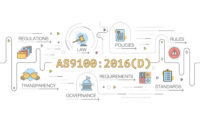The AS9100D transition timeline is moving towards mandatory assessments to the 2016 revision. Much has occurred since fall 2016 including the AS9100-series standard release, auditor training, certification body approval, and, of course, organizational implementation.
All AS9100-series audits will be to the new AS9100-series starting in June 2017 to ensure full implementation by September 15, 2018, when the 2009 revision is retired. So why start the audits in June 2017? Transition to the 2016 revision will require a certification decision and therefore will require not only a transition audit with additional audit days, but also implementation and closure of any issued nonconformances, certification body verification, and technical review of all the associated documentation and audit reports to make a certification decision. The September 2018 date was selected to coincide with the ISO 9001:2015 transition schedules to keep organizations from having to transition first to the ISO 9001 and then to the AS9100D standard.
IAQG (International Aerospace Quality Group) has published a significant amount of Deployment Support Material to help certified organizations with the transition. This information includes presentations, taped webinars, correlation matrices, FAQs, gap assessment worksheet, guidance materials, and links to ISO 9001:2015 support materials at www.sae.org/iaqg/organization/9100.htm.
The remainder of this article will focus on organizational feedback on changes to the AS9100D revision as published by SAE International.
Risk-Based Thinking vs. Risk Management understanding
Risk has always been required by the AS9100 standard. The first release of AS9100 in 1999 required the contract or order be reviewed to ensure that risk associated with new technology and/or short delivery time scales have been evaluated.
AS9100C released in 2009 further required formalized product risk management process to be applied to product realization activities. Organizations are required to plan, implement, and control a process for risk management. Risk management includes requirements for assigning responsibilities, defining risk criteria, identifying and assessing risk, mitigation actions, and the acceptance. These requirements have been carried forward to AS9100D clause 8.1.1 for operational risk management.
In AS9100D, the risk-based thinking concept has been expanded throughout the quality management system as emphasized with the ISO 9001:2015 clause 6.1 addition of Actions to Address Risk and Opportunities. Risk–based thinking promotes proactive thinking throughout the quality management system. The requirements in clause 6.1 specify that the organization shall plan actions to address risks. There is no requirement for formal methods for risk management or a documented risk management process except as denoted in clause 8.1.1 above.
The intent of risk management and risk-based thinking is to:
- Change the organization’s culture and mindset to be proactive.
- Focus on priorities and what adds value to the company.
- Ensure alignment of resources to issues and risks.
- Ensure greater knowledge of risks and improved preparedness.
- Increase the probability of reaching objectives while reducing the probability of negative results
Product Safety Applicability
Product safety has always been implicit within the AS9100-series standard relating to end user experience with the product. Some lower-tiered supply chain organizations are thinking product safety does not apply to them. These organizations do not know how the customer uses their supplied products.
If organizations do not know how their product is used…this is a great opportunity to find out from your customer and understand the potential product safety impacts. Based upon their knowledge of the parts being produced, how can the product be produced so as to meet engineering and product conformity requirements?
Guidance for the implementation of product safety can be found in the clause 8.1.3 NOTE:
- Assessment of hazards and management of associated risks (see 8.1.1)
- Management of safety critical items
- Analysis and reporting of occurred events affecting safety
- Communication of these events and training of persons
Counterfeit Parts does not only apply to electronic parts
The definition of counterfeit parts includes: “An unauthorized copy, imitation, substitute, or modified part (e.g., material, part, component), which is knowingly misrepresented as a specified genuine part of an original or authorized manufacturer. NOTE: Examples of a counterfeit part can include, but are not limited to, the false identification of marking or labeling, grade, serial number, date code, documentation, or performance characteristics.”
The organization needs to assess their risk(s) associated with counterfeit or suspect counterfeit parts and place appropriate controls in place. The clause 8.1.4 NOTE provides guidance on controls to consider including:
- Training of appropriate persons in the awareness and prevention of counterfeit parts including procurement, receiving inspection, inspection, and design personnel
- Application of a parts obsolescence monitoring program for the service life of the product
- Controls for acquiring externally provided product from original or authorized manufacturers, authorized distributors, or other approved sources
- Requirements for assuring traceability of parts and components to their original or authorized manufacturers
- Verification and test methodologies to detect counterfeit parts
- Monitoring of counterfeit parts reporting from external sources
- Quarantine and reporting of suspect or detected counterfeit parts so they are not re-introduced into the supply chain
Testing of Raw Materials is back from Rev B
The testing of raw material requirement in AS9100B was removed in AS9100C due to the introduction of risk management. Unfortunately, risk management was not applied to incoming critical raw materials as anticipated. Therefore, the requirement to validate the accuracy of test reports for raw material identified as a significant operational risk (e.g. critical items) has been introduced. The testing of raw materials in Rev B applied to all raw materials. So the AS9100D requirement has been streamlined and focused depending upon risks.
Human Factors/Error is only “as applicable”
AS9100D introduces the concept of human factors/error in three places in the standard.
- Clause 7.1.4 – This requirement ensures that the work environment is sufficient to ensure operation of its processes to achieve conformity of products and services. Organizations and auditors should determine if the environment is having a negative impact on your organization’s ability to achieve conformity of products and services by examining measures and employment turnover data.
- Clause 8.5.1.g – This requirement ensures that organizations implement actions to prevent human error. Actions can include limiting excessive working hours, providing appropriate training and instructions, automating processes, requiring double electronic entry of critical information, making available devices to avoid incorrect tooling, avoiding distractions for persons, job rotation, requiring completion of information before submission; and mistake-proofing techniques. These techniques will improve product and service conformity by changing the manner in which work is completed.
- Clause 10.2.1.b.2 – This requirement ensures that during the organization’s causal analysis within the corrective action process that human factors are considered. If human factors are not considered, then the true root causes are usually not effective to ensure the nonconformity does not recur. So when the cause is identified as worker error or workmanship, additional analysis is required to determine why.
The new 9100-series standard provides an opportunity for organizations to examine their QMS as they address the new requirements while ensuring their system effectiveness in achieving planned results and improved levels of customer satisfaction. IAQG wishes you success in your implementation and is a resource if you have any 9100-series questions regarding your understanding.



